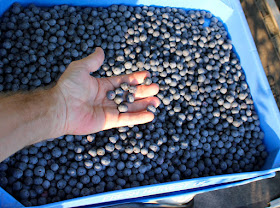below, in the blueberry fields at sundown
While in Mississippi recently I had a little time to walk through some fields of blueberry bushes belonging to one of my cousins. I believe these bushes are most likely Vaccinium corymbosum. They were heavy with ripe berries despite the intense heat and dry. Above: I can never resist those pointless shots directly into the sun. . . for effect. . . and in this wide shot the truck got to show itself in yet another locale (right of image).
Follow Phillip
Like these photos?
See all the unedited photos at
on twitter
The berries toward the tops of the bushes were kind of tough and bitter from baking in the relentless sun. The lower berries were quite sweet. In North America, the most commonly cultivated species is known as the "Northern Highbush Blueberry" (or Vaccinium corymbosum). Hybrids of this with other Vaccinium species have been adapted specifically for southern climates and are collectively and colloquially known as "Southern Highbush Blueberries."
Above: My hand for scale. Below: a flat of recently picked berries. Most of these berries will remain on the bushes and go to the birds as there are not enough pickers this year. My cousin is unable to hire foreigners to pick the berries this year for other reasons. . . so the birds will have a feast. It was miserable in the fields at sunset. The temperatures hovered around 100° F. and the bugs were indefatigable.
Below: Back in Florida, my own blueberry bushes are of the wild variety likely Vaccinium myrsinites (or Evergreen Blueberry). I snapped these shots this afternoon with my hand for scale. While the berries are similar in size and taste. . . mine produce far fewer berries.
I like the bushes and have "cultivated" them. . . or helped them along a little. . . though I don't see any truck crops coming from them anytime soon.
Below: These Paper Wasps (genus Polistes) are a pain, literally. I keep shooing them away with the hose but they return to this large palm frond. Unfortunately it is along one of my paths through the woods. . . and doubly unfortunate for me I'm mildly allergic to their stings. I figure sooner or later they will tire of me shooting them with the hose. I don't like to kill anything. . . so I have to remember they are there. Were they all to sting me at once it would be quite painful.
Below: Speaking of painful. . . these are dozens of mosquito larva. They are common in Florida. . . an insect in the family Culicidae. They are swarming the ponds. Here a large shell has fallen into one of the ponds and provides some nice back lighting so I could get a shot of the larva. I cannot rid the ponds of the mosquitos short of draining the water. (Click on the image for a large view).
Mosquitoes go through four stages in their life-cycle: egg, larva, pupa, and adult or imago. Adult females lay their eggs in standing water. . .the first 3 stages are aquatic and last 5-14 days depending on the species and ambient temperature. Adults live for 4-8 weeks. Judging from the number in my ponds we're in for a bumper crop this year. There are about 3,500 species of mosquitoes so I have no real idea of which species these might be. I wear a modified jungle suit when outdoors, however, so there is very little exposed skin for them to attack.
Below: Redneck, the red-eared slider turtle (Trachemys scripta elegans) has become very tame as I feed him every afternoon. He is as large as a big dinner plate now. He's staying mostly in the biggest pond lately with a pair of young mallards.
Below: I feared that my neighbors massacre of the big oaks had scared away all the squirrels, raccoons, and birds. . . but I found otherwise this afternoon. I bought a bunch of almonds that I didn't like much (they were too roasted). . . so I put them up on the limbs of the oaks and within 30 minutes this little squirrel had come along and started eating the nuts. I'm glad to know some of the wildlife survived the mutilation of the trees.
Below: While there were storm clouds around our area this afternoon we still didn't get any rain. It is painful. At least we know some rain fell nearby and there is a chance that the hot, dry cycle is starting to break. In this image storm clouds over the dry lake threaten. . . but don't deliver.
MISSISSIPPI JOURNAL
I'm slowly going through all the images I took in Mississippi. Below is a shot of my great uncle Jim Leggett's cabin, long abandoned. Click on the image for a larger view. The pond is quite low compared to normal. It was also nearly 100° F. and buggy as I walked around the Leggett farms. The cabin is to the left of image on far side of the pond.
Below: Looking up from the little pond toward the truck you get some sense of how steep a hill exists there. . . and how tall the pine trees. Great uncle Jim's cabin once rested at the very top of the hill but was moved to its current location after his death.
Photo: Cristobal Herrera/European Pressphoto Agency
Miles of Algae
and a Multitude of Hazards
and a Multitude of Hazards
The stench from decaying algae began rising from coastal waterways in southeastern Florida early this month, shutting down businesses and beaches during a critical tourism season. Officials arrived, surveyed the toxic muck and declared states of emergency in four counties, then took off for Cleveland for the Republican National Convention.
Photo: Rhonda Wise/Agence France-Press/Getty Images
Photo: Greg Lovett/The Palm Beach Post/AP
Florida Governor Rick Scott doesn't believe in global warming or climate change anymore than does Donald Trump or Florida Senator Marco Rubio, and why should they care? They don't live amongst the dead fish and dying waterways of southeast Florida, and their reelection campaigns are largely funded by Big Sugar which polluted Lake Okeechobee and caused the algae bloom in the first place.
J.J. Englebrecht, South Africa, Rugby
Matheus Santana, Swimming, Brazil
Derek Drouin, High Jumping, Canada
Paul Ruggeri, Gymnastics, USA
Chad le Clos, Swimming, South Africa
Chris Mears, Diving, Great Britain
Can't Miss:
with #AskTheGays Hashtag
Gays' Response to Trump
above and below
Oh No, He Didn't
Can it be Accidental?
The Donald stuck with boring typography for his new logo.
Boring, if it didn't look like his gigantic 'T' was energetically penetrating Pence's little 'P'
Even CNN is calling it "off color"
others suggested that it looked like what Pence and Trump
would do to America if they somehow won
others suggested that it looked like what Pence and Trump
would do to America if they somehow won





























